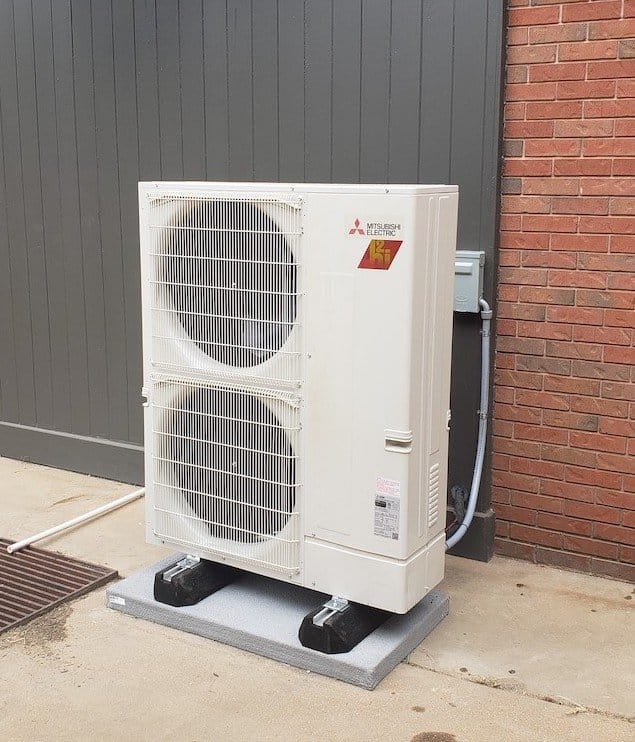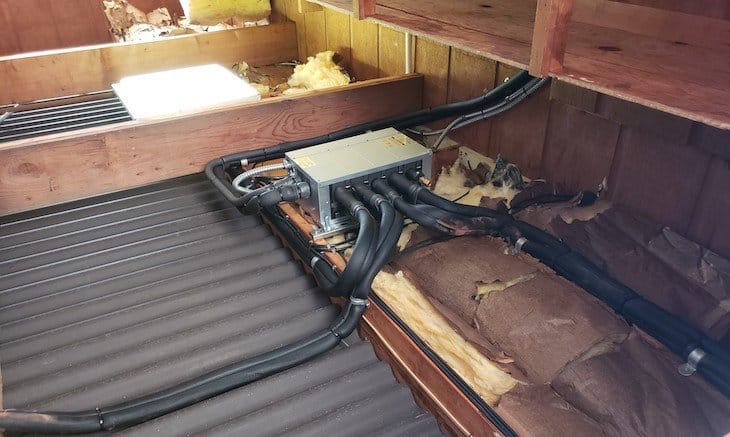A ductless heating and air conditioning system is one that does not use traditional ductwork but instead implements individual units for each room inside a property where heating and cooling is desired. Ductless AC units, commonly called mini-split systems, consist of three main components: an indoor unit, outdoor unit and a remote control. 
Click Below to Jump to Contents
- 3 Main Components of Ductless Systems
- Common Terminology
- Where It Ductless Used?
- Options for Installation
- Pros and Cons
- How It all Works
Three Main Components of Ductless HVAC Systems
The three components of Ductless Heating and Cooling systems are:
- The Indoor Unit: Each unit resides in a room you want to heat or cool and is controlled by its individual remote.
- The Outdoor Unit: There is only one outdoor unit linked to all of the indoor units.
- The Remote Control: The temperature of each room can be set to heat, cool, dry, or auto. You can adjust the fan speed and the direction of the airflow.
Common Names for Ductless AC Systems

- Ductless mini-split system
- Ductless HVAC systems
- Ductless mini-split air conditioner
- Ductless, mini split-system air-conditioners
- Mini-splits
- Mini-split air conditioners
- Ductless air conditioners
- Ductless heat and air
- Ductless heating
- Ductless heat pump
Common Applications for Ductless Heating and Cooling

- Residential Properties including houses, apartments, condos
- Commercial Properties like restaurants, hotels, and stores
- Institutional Properties like schools and churches
- Multifamily housing
- Retrofit add-ons to houses with hot water, radiant panels, or space heater heating systems
- Room additions or small apartments where central AC/heat won’t work
Options for Installation of Ductless HVAC
The most popular options to install ductless heating and cooling includes:
- Ceiling suspension
- Mounted flush into a drop ceiling
- Wall-mounted
- Floor-standing

Advantages and Disadvantages of Mini Split Units
Here’s a breakdown of the pros and cons of ductless heating and cooling from the United States Department of Energy:
The Pros
- Size and flexibility for zoning or heating/cooling individual rooms
- Easy install with little more than a 3-inch hole in the wall for the conduit
- Up to 50 feet between indoor and outdoor units
- Energy efficient (~30% is typically lost through ducts)
The Cons
- System cost per ton of cooling capacity (typically $1500–$2000)
- Must be properly sized and installed or can result in short-cycling or expensive operating costs
- Regular maintenance (which you can do) required. If skipped, it will need a professional cleaning.
- Aesthetically displeasing to some
The Details: What Is Ductless AC?
A ductless air conditioner is exactly what it sounds like: an air conditioner that cools the air without the use of ducts.
First, a standard HVAC system for central heat and air conditioning consists of a system of ducts inside a building’s walls through which air travels to warm or cool the whole building.
However, this isn’t always the best or most feasible way of heating or cooling a home or business. For instance, older homes and businesses undergoing renovation may not have the time, space, or budget to add ductwork. Therefore, an alternative method, like a wall-mounted ductless air conditioner (a popular solution in Europe), is necessary.

How Does Ductless AC Work?
Each ductless AC has an outdoor unit connected to 1–4 indoor units – each with its own remote control. In other words, if you have a ductless AC unit in your bedroom and another in your guest bedroom, you can keep your room at a cool 68 degrees while your guest could keep the temperature of their room at 70 degrees if they wish.
How Do Ductless Heating Systems Work?
A ductless heat pump works the same way as a ductless AC unit. Often times, these systems are dual-use – meaning they work as a ductless HVAC system that heats and cools. Wiring and coolant run from the indoor unit(s) to the outdoor unit and are controlled by the selection you make on the individual unit’s remote for that room.
Why Homes Change to Ductless AC and Heating
The main advantage of a ductless mini-split is that it allows you to control the temperature of individual rooms, which leads to savings in installation, labor, operating costs, and energy efficiency. Plus, maintenance is a DIY job unless you prefer to have a professional do the job or need help with a more technical repair.
This flexibility of use makes ductless heating and cooling systems one of the most efficient HVAC systems available.
Common Ductless Heating and Cooling FAQs
A ductless heat pump is a two-way system of heating and cooling that pushes out warm air from an area to make it cooler and pulls it in from outside to make it warmer.
With recommended manufacturer usage and maintenance followed, most ductless heating and AC systems will last 20 years or longer.
In general, most ductless mini split systems support the heating and cooling of four rooms or designated areas.
Air Conditioning Resources
- Air Conditioner Not Cooling – AC Troubleshooting Guide
- AC Tips for Extreme St. Louis Heat
- Air Conditioning DIY vs. The Professionals
- How Does Air Conditioning Work?
- When to Replace Your Lennox Evaporator Coil
- What Is Ductless AC?
- Preparing Your Air Conditioner for Winter Hibernation
- Before You Flip the Switch from Air Conditioning to Heating
- Choosing a Reliable, Energy-Efficient AC Unit



